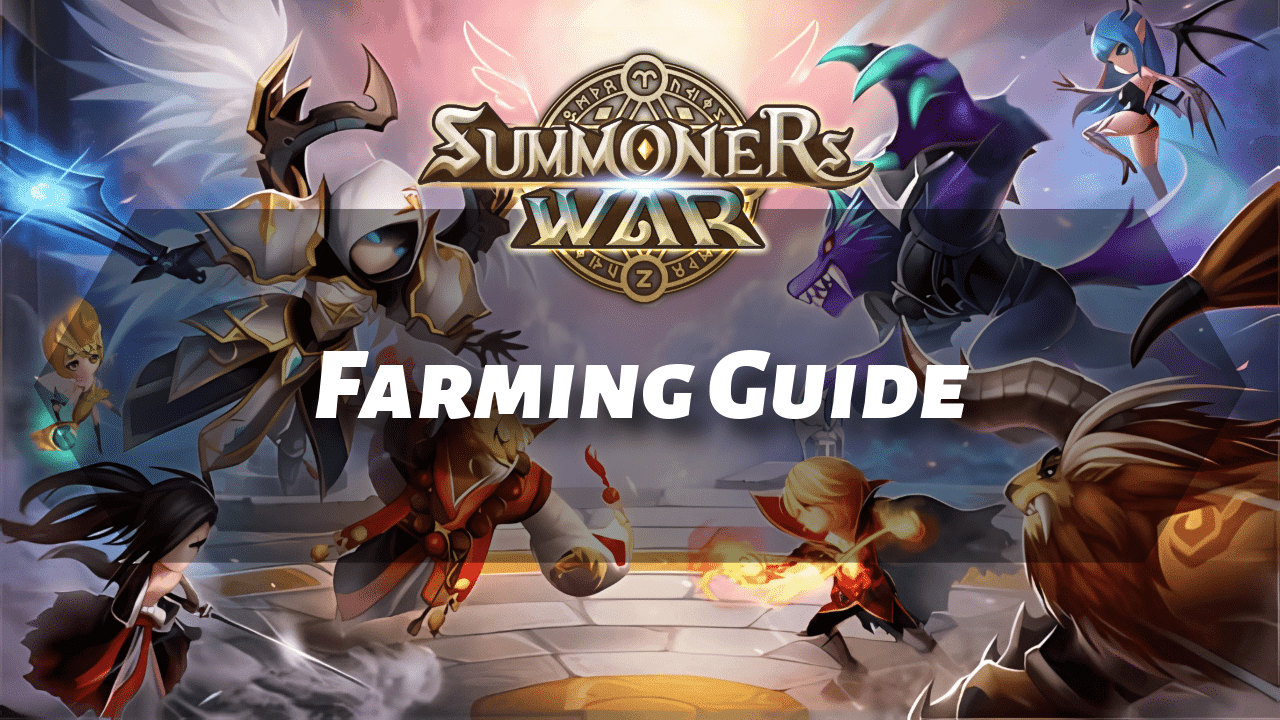
Introduction
Efficient farming is fundamental to making swift and meaningful progress in Summoners War: Sky Arena. As a core aspect of gameplay, it allows summoners to consistently acquire the essential resources needed to strengthen their monsters and unlock further content. These resources primarily include runes, which are the cornerstone of monster power, as well as mana stones for various upgrades and monster materials for evolutions and skill enhancements.
By dedicating time and energy to strategic farming, players can significantly accelerate their journey through the game. Efficient resource acquisition directly translates to the ability to build more powerful monsters capable of tackling increasingly challenging PvE content such as dungeons, Trials of Ascension, and Rift Beasts. Well-runed monsters are also crucial for success in PvP engagements like the Arena and Guild Wars.
To maximize the benefits of farming, it is crucial for summoners to set clear goals. Whether the immediate objective is to acquire a specific set of runes from Giants Keep (GB10) to improve dungeon clear times or to gather materials for a Homunculus from the Rift Beasts, having defined targets will guide your farming efforts and ensure that your energy and time are used effectively. This Summoners War Farming Guide aims to provide you with the knowledge and strategies to farm efficiently throughout your Summoners War adventure, drawing on established progression paths and expert advice.
Early Game Farming (Laying the Foundation)
In the initial stages of Summoners War, your focus should be on completing the Scenario mode. Clearing all the scenarios on Normal difficulty is one of your first objectives, as it unlocks additional game content and provides valuable early rewards. These rewards often include useful rune sets, which can significantly aid your progress, particularly when farming in later stages like Giants Keep B10 (GB10) or farming Faimon Volcano for monster leveling.
To help overcome challenging stages, especially boss encounters within the scenarios, it is highly recommended to make effective use of the rep monsters provided by your friends. These powerful ally monsters can be invaluable in clearing difficult stages that your early monsters might struggle with, allowing you to progress through the scenarios at a faster pace. Having friends with useful rep monsters, such as one capable of farming Faimon efficiently like Lapis, is beneficial. In return, you should aim to set a useful rep monster yourself to encourage other players to add you to their friends list.
Another crucial step in laying a strong foundation is joining a guild as soon as possible. The primary reason for this is the guild rewards, which are exclusively available to guild members. By participating in guild battles and sieges, you will earn guild points that can be spent on a variety of valuable prizes. In the early game, many lower-level guilds readily accept new members, so there is usually no need to request to join high-ranking guilds unless you are a higher level and can significantly benefit them. The bonus guild points earned from participating in guild content can be very useful for acquiring essential resources early on.
Monster Progression and Preparation for Farming
Before you can effectively farm the core dungeons for high-quality runes, it is crucial to develop and prepare a selection of monsters. This involves several key processes: fodder farming (for monster evolution), skill-ups, and awakening. Additionally, understanding which monsters to prioritize for progression is essential to avoid wasting valuable resources.
Fodder farming is the process of leveling up generally less useful monsters, known as fodder, to use as evolution material for your more important monsters. This is a necessary step to increase the star grade of your key units, which significantly enhances their base stats. The primary source of fodder monsters is Unknown Scrolls, which are readily obtained through almost any activity in the game, including scenario battles and even while fodder farming itself. Summoning these scrolls will yield many low-star monsters that can serve as fodder. To speed up the leveling process, it is highly recommended to use XP boosters, which can double the experience gained from battles.
These can be obtained through various in-game events and shops. The most efficient early-game location for leveling fodder is Faimon Volcano on Hell difficulty. You will need a strong farming monster capable of clearing this stage efficiently, often referred to as a “farmer.” Using a friend’s rep monster can be very helpful in the early stages until you have your own capable farmer.
The fodder farming process involves taking your low-star monsters into battles alongside your farmer until they reach their maximum level. Once maxed, they can be evolved by sacrificing other monsters of the same star level. You repeat this process, gradually increasing the star grade of your fodder until you have enough high-star fodder to evolve your desired monster.
Skilling up your monsters is vital for improving their performance in all areas of the game. Skill-ups can increase the potency of abilities and/or reduce their cooldowns. In the early game, the most common way to skill up monsters is by feeding them duplicate monsters of the same family, regardless of their element. Keep all copies of easily farmable monsters like Inugami and Griffon specifically for skill-ups. For key early-game units like Spectra and Belladeon, prioritizing their skill-ups is advised.
Later on, you will gain access to skill books upon reaching Level 21. It is crucial to only use these skill books on the Battle page or the MAX Energy Storage upgrade. Devilmons are very rare and valuable resources that can skill up any monster, regardless of family. It is generally recommended to save your Devilmons for your best natural 5-star monsters, as skill-ups for them through duplicates are very difficult to obtain. You can acquire Devilmons as rewards from events and the Tower of Ascension.
Awakening your monsters is another significant step in strengthening them. This process requires Essences of Magic, Fire, Water, Wind, Light, or Darkness, which are obtained from the Cairos Dungeon (specifically the elemental halls). Awakening provides several benefits, including increased base stats, often a change in appearance, and the unlocking of new skills or enhancements to existing ones.
With a vast number of monsters available in Summoners War, it is important to focus on monsters that offer long-term benefits for your progression. Many monsters are designed for end-game PvP or are primarily “food monsters” used for leveling up or skilling up other monsters. One of the biggest mistakes early players make is investing heavily in monsters that are only useful in end-game content, which can dramatically slow down your early to mid-game progress.
While it’s okay to build one monster you particularly like, making this a habit can hinder your overall development. Prioritize building a core team of monsters that will help you progress through scenarios, conquer GB10, and eventually move on to other essential content like Dragon’s Lair (DB10) and the Tower of Ascension (ToA). For example, Veromos is a crucial fusion monster that not only aids in farming GB10 but is also useful in various other areas of the game.
As you develop your monster roster, focus on building teams with good synergy, where each monster’s abilities complement the others. Many summoners make the mistake of relying too heavily on a single powerful monster or using a team of all the same type, which can lead to survivability issues. A typical well-rounded team often includes a damage dealer, a monster that provides attack or speed buffs, units with debuffs (like defense break), a monster capable of stripping buffs from enemies, and a healer.
Keep in mind that buffs of the same type do not stack, so having multiple monsters with the same buff is generally wasteful. Strategize how each monster contributes to the team as a whole to maximize your chances of success.
Core Dungeon Farming (Acquiring Essential Runes)
Once you have a foundational team of evolved and partially skilled-up monsters, your primary focus will shift towards farming the core dungeons of the Cairos Dungeon: Giants Keep (GB10) and Dragon’s Lair (DB10). These dungeons are crucial as they drop the high-quality runes necessary to significantly strengthen your monsters and progress further in the game.
Giants Keep (GB10)
Giants Keep, Basement 10 (GB10), should be your top priority after completing the scenarios and being able to farm Faimon on Hard mode with your farmer alone. Runes are essential to success in every part of Summoners War, and GB10 drops some of the best universally useful rune types in the game. These include Swift (increased speed), Despair (chance to stun), Fatal (increased attack), Blade (increased critical rate), Energy (increased HP), and Focus (increased accuracy). Unlike Necropolis B10 (NB10), which primarily drops runes for PvP content, GB10’s loot is beneficial for all aspects of the game.
You should aim to build a GB10 team once you have successfully cleared all the scenarios and can consistently clear Faimon on Hard mode with your farming monster. It’s advisable to prioritize completing the Veromos fusion during this stage, as Veromos is invaluable for GB10 and many other areas of the game. You may initially need to farm lower floors of Giants (GB6-8) to acquire runes that meet the minimum requirements for a stable GB10 team.
Your initial focus for GB10 should be on building a team with a high success rate, even if the clear times are slower. Aim for a 100% success rate to maximize your rune acquisition and avoid wasting energy. A common safe early-game GB10 team composition often includes:
Veromos (Leader): Provides a helpful leader skill (HP%) and cleansing abilities.
Belladeon: Offers defense break, attack bar boost, and healing.
Bernard: Provides attack and speed buffs, and attack bar reduction.
Shannon: Offers attack and defense buffs, and glancing hit and attack speed debuffs.
Darion: Provides a party-wide damage reduction passive.
Other potential early damage dealers like Sigmarus or Lushen can be incorporated as your rune quality improves.
While specific stat requirements can vary based on your team composition, some general guidelines include focusing on HP, Defence, and Accuracy for survival and landing debuffs. Ensure your important debuffers (like Belladeon and Shannon) have sufficient accuracy (around 45% is often a good early target) to land their skills reliably.
Dragon’s Lair (DB10)
Once you have a collection of decent runes from GB10, your next major goal should be to build a team for Dragon’s Lair, Basement 10 (DB10). DB10 is where you can obtain the highly sought-after Violent runes, which are considered the most important and widely used rune set in the entire game, beneficial for both PvE and PvP content. Additionally, DB10 drops Revenge and Shield runes, which can be helpful for later content like Necropolis B10 (NB10).
You should consider building a DB10 team after you have been farming GB10 consistently, have acquired decent rune quality, and have summoned or fused the necessary monsters. Generally, being able to clear ToA Normal (Tower of Ascension) consistently with your GB10 team (with the addition of Baretta) is a good indicator that you are ready to transition to DB10.
Similar to GB10, your initial focus should be on a team with a high success rate. Early DB10 teams often require more specific monster skills, such as cleanse (to remove the dragon’s continuous damage debuff), heals, attack bar (ATB) reduction, and potentially ATB boost. A common safe early-game DB10 team composition often includes:
Verdehile (Leader): Provides a crucial leader skill (increased speed) and ATB boost. If you don’t have Verdehile, Spectra can be used as a replacement, although the runs may be slower.
Veromos: Offers cleansing and damage dealing.
Belladeon: Provides defense break and healing.
Megan: Offers attack buff and ATB boost, as well as a debuff.
Sigmarus: A strong water damage dealer.
Alternatively, a team featuring Veromos, Loren, Fran, Spectra, and Verdehile has been used to clear ToaN 100 quickly and could be adapted for early DB10 attempts. Water Geralt (from the Witcher collaboration) was also used in an early DB10 team and could potentially be substituted with Kro (2A) later.
Survivability is key in DB10. Aim for 20k+ HP for non-Water monsters and 18k+ HP for Water monsters, along with at least 700 Defence. Debuffers like Belladeon and Loren should aim for around 55% accuracy to reliably land their skills on the dragon. Your monsters should also have 200+ speed on Swift or non-Violent runes, including speed tower bonuses, to keep up with the dragon’s turns.
Remember that consistency is paramount when you first start farming these core dungeons. Aim for reliable clears before focusing on speed. The runes you acquire from GB10 will help you build a more stable and eventually faster DB10 team, which in turn will provide the Violent runes needed to tackle even more challenging content in Summoners War.
Other Important Farming Areas
Beyond Giants Keep (GB10) and Dragon’s Lair (DB10), several other farming areas are crucial for progression in Summoners War. These areas provide different essential resources that will further strengthen your monsters and enable you to tackle more challenging content.
Necropolis B10 (NB10) becomes important once you have a substantial amount of Grindstones and Enchanted Gems from Rift Raids to enhance your existing rune collection. NB10 primarily drops rune sets that are particularly valuable for PvP content such as Arenas, Real-Time Arena, and Guild Wars. These sets include Rage (increased critical damage), Will (immunity to debuffs for one turn at the start of battle), Vampire (lifesteal), Revenge (chance to counter-attack), Destroy (reduces enemy’s max HP), and Nemesis (increased attack bar when HP is lost).
It is recommended to prioritize farming Rift Raid Level 5 (R5) before venturing into NB10. While the runes from NB10 don’t significantly aid in R5, the Grindstones and Enchanted Gems from R5 will greatly facilitate your progress in NB10. Necropolis is often considered slow to farm and may require specific team compositions to overcome the boss’s unique mechanics, such as the ability to steal turns.
Farming the Rift Beasts (Fire, Water, Wind, Light, and Dark) becomes instrumental in obtaining high-quality runes to speed up your teams. The Rift Beasts provide free Grinds and Gems, which offer an extra boost to your rune stats, helping you break into harder content. However, it is not recommended to focus on Rift Beasts if you cannot consistently achieve at least an A+ rank, as the lower-level rewards are not significantly valuable.
For the Wind Beast, building a wind homunculus with Max HP damage traits is suggested. Early game teams might include units like Roal (Wind Harg), Riley (Water Fairy), Eshar (Wind Harpy), Verdehile (Fire Vampire), and Kro (Dark Inugami). The Dark Beast requires multi-hitters for effective damage, and for the Light Beast, hitting through the shield is necessary to damage the boss. Once the homunculus is complete, Rift Beasts are not a major focus.
Rift Raid (R5) and Solo R4 are considered excellent sources of mana farming and provide plenty of Grindstones. Blue Grindstones can be sold for mana. R4 is an acceptable alternative if you cannot farm R5 consistently, although it yields fewer Hero-grade Grindstones. R5 farming provides short-term progression through rune enhancement with Grindstones and Gems. The core of Solo R4 and eventually R5 farming is often the BJR5 team, which offers great damage and survivability.
This team requires significant investment but can become one of your strongest. The Spiritual Realm dungeon is farmed for fight runes needed for BJR5. It is advised to do more R5 farming if your units do not have at least some legendary stats on their runes. You shouldn’t farm mana specifically, as it is a byproduct of farming what you need, except for artifact dungeons. Rune dungeons and R5 provide good mana profit.
Steel Fortress (SF10) and Punisher Crypt (PC10) become important for building stronger monsters and preparing for faster rune farming and more reliable raids. These dungeons introduce Artifacts, which add additional power to your monsters, making gameplay faster and more efficient. It is recommended to attack SF10 before PC10, as PC10 is generally more difficult and requires higher quality runes for successful completion. For SF10, a team might involve Zinc (2A), Gina, and other damage dealers. For PC10, a team could include Icaru (2A), Raoq, and Jansen.
Abyss Floors (Giants Abyss, Dragons Abyss, Necro Abyss, Steel Fortress Abyss, Punisher Crypt Abyss) are where you go to improve your rune rates. They offer Intangible runes, which can complete any rune set, providing valuable flexibility in building monsters. Dragons Abyss Normal and Hard (DAN & DAH) and Necro Abyss Normal and Hard (NAN & NAH) provide guides for team compositions and rune builds for these floors.
One perspective suggests prioritizing Dragons Abyss (DBaH) over Giants initially because in the very beginning, rune sets matter less than rune quality, and DBaH can provide a consistent and faster source of usable runes. The AOE revenge of the Abyss Giant’s boss can also make early Giants teams with units like Fran and Loren less effective. However, some suggest farming Giants instead of Dragons or Necro early to mid-game because many damage dealers scale with attack (Fatal runes), and you need to farm Swift and Despair runes extensively from Giants.
Tower of Ascension (ToA) and Tower of Ascension Hard (ToaH) are great ways to farm additional resources. You should always try to get as far as you can in ToA/ToaH whenever you have the chance. Free ToA events are perfect for rushing remaining stages. It is possible to clear ToaH 100 relatively early using a dot team with control units like Spectra and Veromos. Clearing ToA after around 29 hours of play has been reported.
In the Secret Dungeons (SDs), you need to collect essential units such as Loren (Light Cowgirl), Kro (Dark Inugami), Belladeon (Light Inugami), Kumae (Dark Yeti), and Jansen (Dark Viking). These units are necessary for various aspects of progression. The Global Server secret dungeon channel is 1050. Focus on getting your first copy of these units unless you can consistently clear stage 10 of the SD.
For Arena, you should always use your arena wings and never let them reach 10/10. Prioritize finishing Rank 1 in the Novice league for the 300 glory points each week. During weekdays, set one monster defenses and try to get into “revenge loops” to maximize glory point gain.
Joining a farming guild as soon as possible is important. You don’t need a high-rank guild initially; the goal is to get the buffs and free guild points. As you battle other guilds and enter sieges, you receive guild points, which can be spent on valuable prizes.
Clearing the Scenario is important as many things unlock upon completion. Faimon Volcano on Hell difficulty is the fastest way to get XP for monsters for fodder farming. Using a strong water monster like Lapis can make this efficient.
The Dimensional Hole uses a separate energy source that recharges over time. It allows you to farm Ancient Runes and materials to craft Ancient Reappraisal Stones. Ancient Runes can be crafted by selecting runes from different dimensions.
R5 is generally considered the best place for mana farming if you are selective with what runes you keep, auto-selling blues and most flat purple runes. Fast solo R5 teams are unbeatable for mana gains. Dark Rift Beast can also be a good source of mana by selling the gems obtained, although SSS rank is not guaranteed. Mana is generally acquired as a byproduct of farming rune dungeons and Rift Raids. Avoid farming artifact dungeons for mana.
While Faimon Volcano (Hell) is optimal for early to mid-game fodder farming, other scenario areas can be used depending on your farmer’s capabilities and desired drops. Later in the game, you might consider other areas if you need specific monster drops for skill-ups while leveling fodder.
Remember to set your goals for farming each area based on your current progression needs. Focus on achieving consistent clears before optimizing for speed.
Resource Management in Farming
Efficient resource management is essential for progression in Summoners War, especially when farming across various dungeons and content. Managing energy, mana, crystals, arena wings, guild points, time, and other resources can help maximize your farming efficiency and keep your progression smooth.
Energy is a crucial resource in the early and mid-game. To optimize its usage, focus on farming dungeons and content that align with your current progression goals. Early on, prioritize farming Giants Keep (GB10) for essential rune sets. Be mindful of energy costs, especially in areas like Rift Beasts, where rewards may not justify the high energy investment if you can’t achieve at least an A+ rank. Maximizing efficiency through faster and more consistent runs ensures that you get the most out of your energy. The Dimensional Hole offers a separate energy source, which allows you to farm Ancient Runes and materials for Ancient Reappraisal Stones, adding another layer of progression.
Mana is a vital resource used for powering up runes and other activities. Farming Rift Raid Level 5 (R5) is an effective way to accumulate mana, as blue Grindstones obtained from R5 can be sold for a significant mana gain. Dark Rift Beast also offers mana by selling gems. Generally, mana is acquired as a byproduct of farming rune dungeons and Rift Raids, so focus on farming what you need, and mana will accumulate naturally. It’s best to avoid farming artifact dungeons specifically for mana, as they are not a reliable source.
Crystals are a premium currency that should be used strategically. A common use of crystals is to recharge energy for continued farming, but it’s important to weigh the trade-off between time and crystals. If you have more time, using slower, more consistent teams can prevent wasting crystals on failed runs. Free-to-play players should consider recharging energy no more than twice a day, as repeated requests for recharges can cost significant amounts of crystals, reducing overall profits.
Arena wings are another valuable resource. Always use your arena wings before they reach the maximum of 10 to avoid wasting potential Glory Points. Aim to finish Rank 1 in the Novice league each week for the 300 Glory Points and participate in “revenge loops” by setting weak defenses to maximize Glory Point gains through successful revenge battles. These Glory Points can then be spent on valuable resources like Rainbowmons and Devilmons.
Joining a farming guild as early as possible is a key strategy. A guild provides beneficial buffs and free guild points, which can be spent on valuable prizes in the guild shop. Participating in guild battles and sieges helps you earn additional guild points, contributing to faster progression.
Time management plays a significant role in resource optimization. If you have limited playtime, prioritize using speed teams for dungeons, even if they require more frequent crystal expenditure for energy refills. If you have more time available, consider using highly consistent but slower teams to conserve crystals. Setting short-term, achievable goals for farming can keep you motivated and make your resource investment feel worthwhile.
Rune management is a core aspect of progression. In the early game, focus on 2, 4, and 6 slot runes, aiming for percentage-based main stats (except for speed on slot 2). Maximizing your success rate in dungeon farming is crucial to ensure high-quality rune drops and overall resource efficiency. Even small failure rates can lead to significant losses over time. Later in the game, using Grindstones and Enchanted Gems from Rift Raids and R5 is essential for enhancing the quality of your runes. Additionally, the Dimensional Hole offers materials for crafting Ancient Runes and Ancient Reappraisal Stones, providing another layer of rune progression.
Fodder management is also critical for advancing your key monsters. Fodder farming involves leveling up and evolving low-grade monsters for use as evolution material. Faimon Volcano on Hell difficulty is the most efficient location for XP farming to level up fodder monsters. Using XP boosters can significantly speed up this process. Additionally, be mindful of unknown scrolls needed to summon fodder monsters, as they are easily obtainable through various game activities.
By strategically managing these resources and aligning your farming efforts with your progression goals, you can maximize the efficiency of your time and energy in Summoners War, ensuring smooth and steady progress throughout the game.
Advanced Farming Strategies
Advanced farming strategies in Summoners War focus on optimising resource acquisition and ensuring consistent progression across various stages of the game. As you move beyond early game content, targeted farming based on your specific needs becomes crucial. In the mid to late game, dungeons such as Dragon’s Lair (DB10/DB12) should be prioritised for Violent runes, which are essential for both PvE and PvP content.
Achieving a consistent and fast DB10 team marks a significant step in your progression. Similarly, Necropolis (NB10/NB12) is key for obtaining Rage, Will, and Vampire runes, which are valuable for PvP and damage-dealing monsters. However, farming NB10 can be more challenging and slower, requiring careful team building. Steel Fortress (SF10/SF12) and Punisher’s Crypt (PC10/PC12) become essential for farming Artifacts, which provide significant boosts to your monsters’ power. SF10 is generally recommended before PC10 due to its lower difficulty. The decision of which dungeon to farm can also depend on events, such as rune picking events, where you might target specific rune sets.
Optimising for speed and consistency is crucial in advanced farming. Teams that can clear dungeons quickly and with a 100% success rate allow you to maximise the number of runs within a given time or energy. Even a small failure rate can lead to significant losses in potential runes and resources. Transitioning from early game safety-focused teams to faster and reliable teams is key to advancing in the game.
Rift Beasts and Rift Raids (R5) are essential for acquiring high-quality materials. Rift Beasts provide Grindstones and Enchanted Gems, which are vital for enhancing your runes, but only if you can achieve at least an A+ rank. Rift Raid Level 5 (R5) is an efficient way to obtain Hero and Legend grade Grindstones and Enchanted Gems, which are essential for optimising your rune quality. Many players prioritise R5 farming before fully committing to Necropolis due to the value of the rewards, which help improve runes for all areas of the game.
As you progress further, Artifacts from Steel Fortress and Punisher’s Crypt become increasingly important. These items enhance your monsters’ stats, improving your overall account power and dungeon clear times, as well as boosting your performance in PvP. Focusing on farming these dungeons for Artifacts is an advanced strategy to improve your overall game performance.
The Dimensional Hole offers a separate energy source, allowing you to farm materials for Secondary Awakening and Ancient Runes. This provides an additional path for rune progression, distinct from regular dungeons. The Dimensional Hole energy recharge system allows you to farm materials while continuing your normal farming activities.
In the later stages, the focus shifts to improving rune quality rather than simply increasing rune depth. If your core units lack legendary substats, focusing on Rift Raid 5 for Grindstones might be more beneficial than farming new runes. Continuously upgrading your best runes with Grindstones often provides more immediate power increases than endlessly searching for perfect base runes.
Summoners War frequently features events that provide excellent opportunities to accelerate farming progress. Rune picking events, for example, allow you to target specific rune types, while free ToA events offer an opportunity to push through the Tower of Ascension for valuable rewards. Using these events strategically can help maximise your resource gain.
Efficient fodder farming is another key to progression. Continuously six-starring your monsters is essential, and advanced fodder farming involves optimising the process for speed and efficiency. Using XP boosters to double the experience gained from battles is a helpful strategy. Farming in Faimon Volcano on Hell difficulty is generally the most efficient XP farming location once your farmer is strong enough. Additionally, using friend reps to clear stages faster while levelling fodder can further speed up the process.
While AFK farming is more associated with Summoners War Chronicles, in Sky Arena, the concept translates to ensuring your repeat battles in dungeons run consistently and effectively while you are not actively playing. This strategy optimises your farming even when you’re away from the game.
By implementing these advanced farming strategies, you can enhance your efficiency and accelerate your progression through Summoners War, making better use of your time, energy, and other resources as you move through the game’s various stages.
Progression Milestones and Farming Focus
In Summoners War, progressing through various stages of the game involves focusing on specific farming goals and milestones to efficiently develop your team and resources. Early in the game, the first major milestone is to complete all Scenario Battles on Normal mode. This unlocks essential content and rewards, while also allowing you to level up your starting monsters and a farmer monster, such as Lapis. Completing Summoners Way tasks is crucial for gaining early rewards.
At this stage, focus on farming Faimon Volcano for efficient XP, and use friend representative monsters (reps) to clear difficult stages. It’s also important to keep all Inugami and Griffon copies for skill-ups and to buy Rainbowmons and Devilmons from the shop each week. You should only use crystals for energy refreshes and always use your arena wings to gain Glory Points.
As you transition to the mid-early game, your goal is to build a team that can consistently conquer Giant’s Keep B10 with a success rate of 85-90%. Start by farming the lower floors of GB (GB6-8) to obtain runes that meet the minimum stat requirements for GB10. Fuse Veromos early, as this monster is key for both GB10 and other early content. Aim for runes with percentage-based main stats on slots 2, 4, and 6, except for speed on slot 2. Skill up your core GB10 team members with family monsters and join a guild as soon as possible for guild rewards. At this point, you should focus on progressing through Scenarios, Summoners Way, Faimon Volcano (Normal), and GB10.
In the mid-game, once you have a reliable GB10 team, your next goal is to conquer Dragon’s Lair B10. Farming DB10 allows you to acquire Violent runes, which are vital for both PvE and PvP content. Focus on achieving a high success rate with your DB10 team, prioritising consistent clears. A common early DB10 team includes Verde (L), Spectra (2A), Veromos, Loren, and Water Geralt (later Kro). Alongside DB10, clearing Tower of Ascension Normal each month becomes a priority for valuable rewards like Devilmon and scrolls. Units such as Spectra and Veromos are particularly useful in ToA.
In the late-mid game, you should work on achieving consistent clears in Necropolis B10. At this point, you will want to build a team that can reliably farm NB10 to acquire Rage, Will, and Vampire runes, which are essential for PvP. Some players may prioritise DB10 over NB10 for Violent runes, which are more versatile. Additionally, farm Rift Beasts to at least A+ rank, as this will provide you with Grindstones and Enchanted Gems to improve your rune quality. Work on Rift Beast teams during times when you have free energy and can achieve A+ ranks to ensure efficient rewards. Wind Homunculus, which requires farming Wind Rift Beast, is another important progression goal.
As you approach the late game, the focus shifts to optimising and farming Rift Raid Level 5 (R5). R5 is critical for obtaining high-quality Grindstones and Enchanted Gems to maximise your rune potential. The rewards from R5 also include a significant amount of mana. It’s recommended to farm R5 before fully committing to NB10, as the rewards from R5 are highly beneficial for enhancing runes across the game. At this stage, farming Steel Fortress (SF10/SF12) and Punisher’s Crypt (PC10/PC12) becomes essential to acquire Artifacts, which significantly boost your monsters’ stats and enhance your team for all areas of the game. SF10 is generally tackled before PC10 due to its lower difficulty.
In the final stages, focus on progressing through Abyss Floors, which offer Intangible runes that can complete any set, allowing for greater customisation and power. These floors can be challenging, requiring high-quality runes to succeed. Finally, once you have a strong foundation of runes and artifacts, you can shift your focus to end-game PvP content such as Arena, Real-Time Arena (RTA), and Guild Wars, dedicating resources to monsters and runes specifically for these modes.
Throughout all stages of the game, fodder farming remains essential to six-star your key monsters and continue progressing. Efficient mana management is also crucial for upgrading runes and other in-game activities. As you progress, always aim for consistent and eventually faster clear times in all dungeons to maximise your farming efficiency.
Conclusion
In conclusion, consistent progress in Summoners War relies on a clear understanding of progression milestones and a strategic approach to rune and resource farming. The journey begins with completing Scenario battles and Summoners Way tasks to lay a solid foundation and acquire early resources.
The focus then shifts to building a reliable team for Giant’s Keep B10 (GB10), as high-quality runes are essential for success in all aspects of the game. Veromos is a key fusion monster to aim for during this stage, as it greatly helps in clearing GB10.
Once you have a consistent GB10 team, the next major goal is to conquer Dragon’s Lair B10 (DB10) to acquire Violent runes, which are vital for enhancing your monsters’ capabilities and advancing your account. Simultaneously, clearing Tower of Ascension Normal (ToAN) monthly provides valuable rewards such as Devilmons and scrolls.
As your rune quality improves, your next priority will be Necropolis B10 (NB10), to farm Rage, Will, and Vampire runes, although some players might choose to further strengthen their DB10 team first. Farming Rift Beasts to at least an A+ rank becomes crucial to acquire Grindstones and Enchanted Gems for further enhancing your runes.
In the late game, optimizing rune quality through Rift Raid Level 5 (R5) becomes vital, as it provides the highest-grade enhancement materials. Progressing through the challenging Abyss Dungeons and farming Artifacts in Steel Fortress and Punisher’s Crypt also becomes a key focus for maximizing your monsters’ potential.
Throughout all stages, efficient fodder farming is essential to six-star your key monsters and continue progressing. Advanced farming strategies, such as targeting specific dungeons based on current needs, prioritizing speed and consistency in dungeon runs, and strategically utilizing in-game events, can significantly accelerate your overall progression. Even small improvements in success rates can lead to substantial gains in resources over time. The ultimate goal is to build well-coordinated teams with optimized rune builds to conquer all PvE content and excel in PvP.













